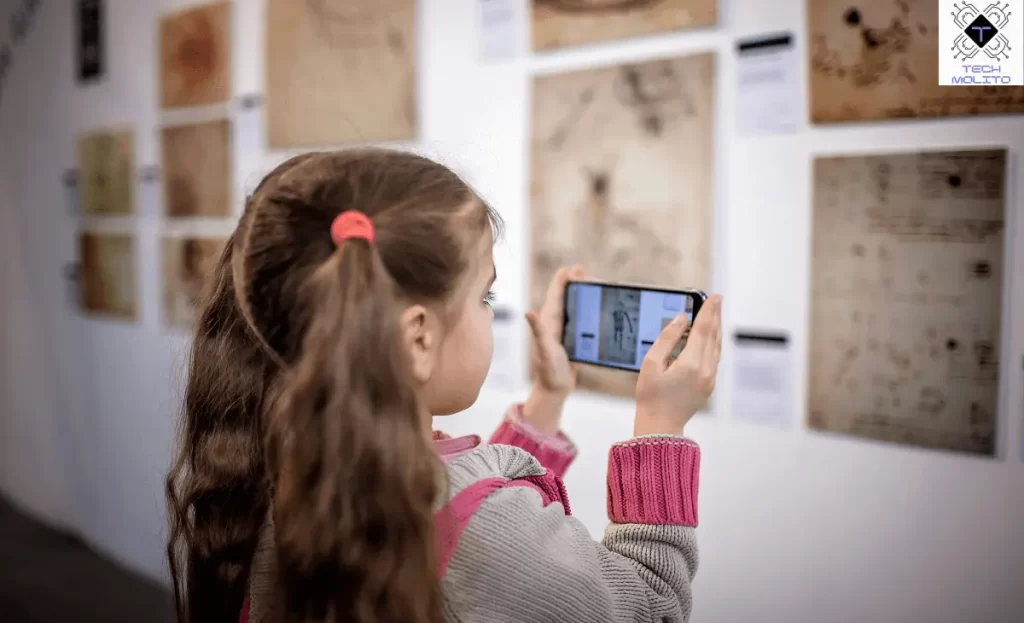Augmented Reality in Education puts digital things over our real world. It’s not the same as Virtual Reality (VR), where we are fully in a digital world. AR adds digital parts to real life.
In learning, this means we can do more than just read about a topic. We can see it come to life. For example, when learning about the planets, AR lets us see planets orbiting in real-time. AR makes learning more fun to watch, which helps us remember it better.
Problem: Old ways of learning can sometimes feel dull. Books, talks, and tasks may not keep us focused. In today’s fast-paced world, we need something new that makes learning fun and hands-on.
Agitation: We’ve all seen how gadgets take over. Games and social apps grab our focus more than textbooks. Why can’t learning be as fun as these? It can be! There’s a way to make dull lessons exciting.
Solution: Augmented Reality (AR) is changing learning. It blends digital things with real lessons. It helps us see and grasp ideas better. Let’s look at how AR makes learning fun and active.
How Augmented Reality in Education is Changing Learning
AR is not just a cool tool; it changes how we learn with real perks. One key plus is that AR makes lessons more fun and active. When students enjoy what they do, they learn better and keep facts for longer. Another perk is better memory; seeing things in action helps us hold on to facts for a long time.
AR lets us learn hands-on by showing real-life events, making it great for subjects like science or history. Lastly, AR gives a cheap option for learning, as there is no need for costly models or lab setups, offering a low-cost way to see tough ideas.

Real Uses of Augmented Reality in Schools
Here’s how AR is used today to boost learning:
Fun Science Lessons
AR makes biology, chemistry, and physics pop with fun. Imagine cutting open a frog on screen or watching atoms form in 3D. Students can explore hard processes in a fun way. They can see ideas that are tough to grasp in regular formats, leading to a deeper understanding.
This active way not only keeps students interested but also sparks their curiosity about the natural world. Overall, AR turns science lessons into memorable moments that inspire a love for learning.
History Lessons Brought to Life
With Augmented Reality, students can travel back in time to see the past. They can view old cultures, witness key events, and meet historical figures. This hands-on experience helps learners connect with history on a personal level.
By seeing history unfold right before them, students can better grasp the impact of events and cultures. It creates a vivid story that makes learning more engaging and real. Overall, AR brings history lessons to life, changing how students see the past.
Learning Languages with Augmented Reality
Apps like Mondly use AR to teach languages in a fun way. We can talk to virtual people, making language learning feel real and useful. This tech helps break down language walls by giving context and visuals.
It allows learners to practice in real-life situations, boosting memory and understanding. The fun format keeps students more eager to keep learning. Overall, AR changes language learning, making it more lively and effective.
Geometry in 3D
Students can see shapes and solve math tasks in 3D with AR, making learning fun and engaging. This hands-on way helps make tough ideas clear and easier to understand. Visualizing shapes helps solidify knowledge and sharpen problem-solving skills.
It also lets learners play with shapes and sizes in real time. The interactive side of AR keeps students engaged and motivated in their math journey. Overall, AR boosts geometry lessons by making hard ideas real.
How Does Augmented Reality Improve Learning?
AR’s power is in making learning feel real. When we use more than one sense, we remember better. Studies show that students using AR score higher and remember things longer than those who use old methods.
- Fun: We learn better when we join in.
- Seeing: Watching ideas in 3D helps us grasp them faster.
- Group Work: AR helps group tasks, building teamwork skills.
Benefits of Augmented Reality for All Ages
- Young Students: AR adds joy to learning. It keeps kids tuned in with fun content.
- Middle School Students: At this stage, topics get tougher. AR helps explain these ideas and makes learning hands-on.
- High School and College Students: For older students, AR offers deep dives into subjects. From engineering to health, AR shows real-life scenes, making it feel more real.
Challenges to Using Augmented Reality in Schools
While AR has big perks, there are some roadblocks that need to be fixed. One major issue is cost; some schools may find it too costly to buy AR tools, which can limit their chance to use this tech well.
Another challenge is access to devices; not all students have access to AR-ready devices like phones or tablets, which creates a gap in learning chances.
Also, teacher training is key; teachers need to learn how to use AR tools well to fit them into their lessons. As tech grows and improves, these hurdles are slowly fading, making it easier for schools to use AR.
Future of Augmented Reality in Schools
AR is still growing. As tech improves, we’ll see more schools use AR every day. Companies are making new AR apps that are cheaper and easier to use.
In the future, AR could make learning personal. Each student could have a custom AR lesson that fits their speed and style. This way, each student gets the right kind of help to learn better.
FAQs
1. What is the difference between AR and VR?
AR adds digital parts to our real world, while VR puts us in a full digital world.
2. How does AR help students learn better?
AR makes learning more hands-on and visual. It uses many senses, which helps us hold on to facts longer.
3. Do schools need special tools for AR?
Many AR apps work on phones or tablets. Schools don’t need to spend big, but students do need these gadgets.
4. Is AR only for science?
No! AR can be used for any topic, from history and reading to math and language learning.
Conclusion
Augmented Reality in Education is changing how we learn. It adds fun to classes and turns dull lessons into something fresh. From young students to college, AR has something for all of us.
While there are roadblocks, the perks are worth it. AR makes learning visual, hands-on, and fun. As tech keeps getting better, AR will play a bigger part in how we learn. Let’s use this cool new tool to make learning more exciting!





